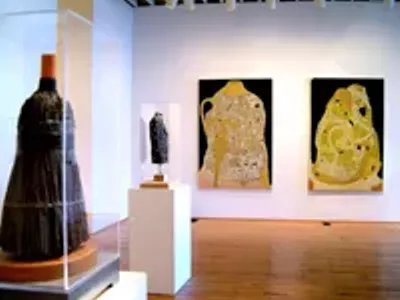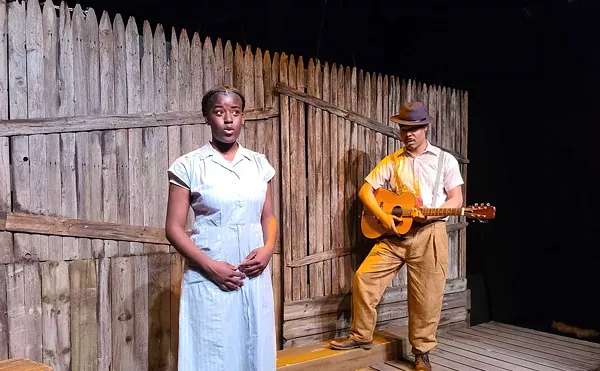
Audio By Carbonatix
[
{
"name": "GPT - Leaderboard - Inline - Content",
"component": "35519556",
"insertPoint": "5th",
"startingPoint": "3",
"requiredCountToDisplay": "3",
"maxInsertions": 100,
"adList": [
{
"adPreset": "LeaderboardInline"
}
]
}
]
After 12 years of operation, Revolution gallery in Ferndale will close at the end of this month. Distress is felt throughout the community as one of the city’s most important art venues disappears, leaving a hole in Detroit’s cultural fabric. While there are other art spaces, Revolution will be hard to replace.
“Do I wish it would continue forever? Of course,” gallery director Paul Kotula says. The same entrepreneurial spirit that led Meg LaRue, the gallery’s financial backer, into the project, is now leading her toward another one just as farfetched: a holisitic learning and living community near Grand Rapids.
Revolution gallery maintained an aesthetic vision rare in the commercial art world, regardless of location. Many New York gallery back rooms are filled to pay the bills; not so at Revolution. Their emphasis on cutting-edge art brought much-needed fresh air to Detroit’s oxygen-deprived audiences.
It was the brainchild of Kotula, who worked at Royal Oak’s Swidler Gallery after graduating in the late 1980s with a master’s from the renowned ceramics program at Alfred University. Kotula says that when Swidler (which focused mainly on clay) closed in 1992, he wanted to show ceramics, fabric wall hangings, videos and oil paintings, all on equal footing.
He was also teaching at the College for Creative Studies. LaRue, one of his students, was a collector and a Swidler client. “I approached Meg with the idea, and she was incredibly supportive,” he says.
Another Kotula student and friend of LaRue, Joanne Park-Foley, also was interested. So with a start-up bankroll mainly from LaRue, the trio plotted their course in Kotula’s basement for almost a year.
The gallery was originally to be in the Russell Industrial Center, off I-75 and Grand Boulevard, where Kotula’s studio is. But it became clear that collectors wouldn’t go there. “I thought I could just do my work and when people came, I could clean up and consult with them,” Kotula says. “But my clients just weren’t that enthusiastic.”
Then a storefront on Woodward in Ferndale caught Kotula’s attention. It took an artist’s eye to see what it could become. The space was an automotive accessory dealer, its architecture 1970s faux chalet. It had an orange-and-brown color scheme and simulated timbers and gingerbread. “There were even clapboard shutters covering the heaters,” Kotula says, laughing.
The group transformed the space into an austere white cube with polished concrete floors and high ceilings to rival any New York gallery. They rented the adjacent corner storefront to control the look of the building’s entire façade, which also put them in charge of a billboard facing Woodward. Sandra Schemske, who joined Revolution from Susanne Hilberry Gallery, proposed using the billboard for temporary exhibitions.
Kotula was initially skeptical, but the artist’s billboards were a success. In 1999, they were featured in a Massachusetts Museum of Contemporary Art survey of artist’s billboards from around the United States. The billboard project is no longer connected with Revolution, an economizing measure taken a few years back.
Revolution broke ground in other ways. The idea of a premier art gallery in Ferndale, in the days before the community was a gleam in a gentrifying real estate broker’s eye, was risky. But Kotula sensed that Ferndale was up and coming, and LaRue had faith in Kotula’s judgment, despite the fact that one of their neighbors would be a tattoo parlor. But then Lemberg Gallery, Susanne Hilberry Gallery, Donna Batista Gallery and others followed suit, many abandoning Birmingham for fashionable Ferndale.
Perhaps Revolution’s most enduring legacy will be bringing people and ideas together. This happened at exhibiting-artists’ dinners featuring eclectic guest lists. (The one for Manglavo-Ovale, then barely known outside of Chicago, included the late art doyenne Mary Denison and her companion, the sculptor Gary Kulak, mega-collectors Stuart and Maxine Frankel, and writers Lynn Crawford, Glen Mannisto and me, all having coffee — from LaRue’s collection of hand-thrown ceramic mugs — and art talk, deep into the night.)
But unexpected encounters were equally important, like the time Conrad Bakker held a sidewalk sale outside the gallery and two women from New York Bagel Factory across the street came over for it. One was upset to find that it wasn’t second-hand junk, but hand-carved wooden reproductions of second-hand junk. The other was enchanted.
Vince Carducci is a freelance writer for Metro Times. Send comments to letters@metrotimes.com




